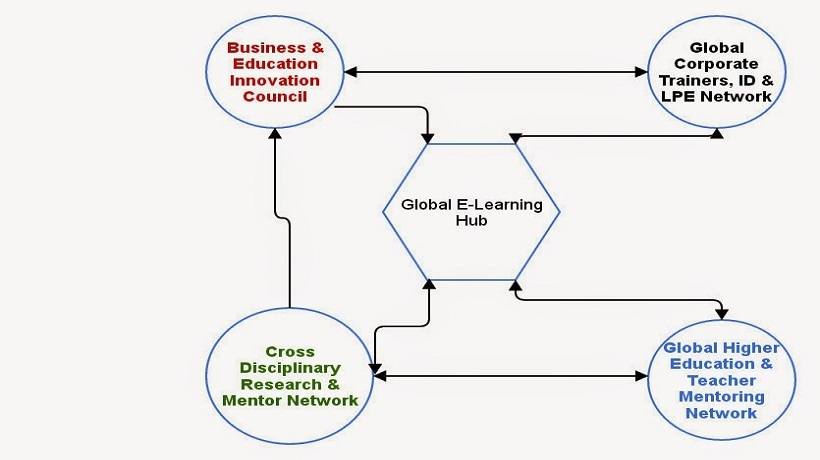Reskilling Or Upskilling To Meet The Future?
It was suggested in the last article that perhaps the future of global business lies in the great potential of the cloud coupled with the development of quantum computer farms. For instructional designers, the approach of learning experience design (LXD) has become even more important than the more traditional, formulaic approaches. What points us to this approach is the rise of the importance of learning science for instructional design in the 21st century. Like it or not, the way people learn has changed as a result of what I have termed the "perfect storm" of advancing technologies such as AI, big data, the cloud, the exponential growth of cross-disciplinary information, and change management. This perfect storm has accelerated our experience as a result of the impact of the COVID-19 global pandemic. Links to new and advancing technologies dictate that instructional designers need to up their game as illustrated in the YouTube presentation below titled "Clark Quinn on Learning Science for Instructional Design-Learning Experts Talk #026" hosted by Alex Salas.
https://www.youtube.com/watch?v=YwPR5IMSkU8
This brings us to 2 important questions:
- Given the convergence of these technologies in the practice of instructional design, what will the most suitable environment look like to capitalize on these useful technologies, especially when we will be working on a global scale rather than the present localized environment?
- How can we bring together all those individuals whose expertise is really needed in creating effective, efficient, and engaging learning experiences for employees who will have most of their reskilling or upskilling done in an online environment?
Global Business eLearning Hubs: Part I
If we are quickly moving toward doing 99% of global business on the web, it is important that we become familiar with the advances of the web and how we can innovate so that we have fast, efficient, and engaging global networks to create effective learning experiences for our employees. Our staff needs to feel they are valued stakeholders in business organizations. In the 21st century, capitalizing on a company's intellectual assets should be a higher priority for decision-makers compared to the past. Local cross-disciplinary communities need to be transformed into globally networked cross-disciplinary communities.
To accomplish this, our employees need to have 24/7 access, through any digital device, to what I would term as a "quantum global eLearning hub." This hub would be a digital gateway to task areas related to areas of networked expertise that fit with our area of specialization.
In order to understand how this works, we need to see how the World Wide Web has progressed from the original conception to the present and especially to what it is becoming. To explain this progression, the YouTube presentation below titled "What is Web 3?" by bfresh explains the progression very well.
Another YouTube presentation titled "Why Web 3 is the Next Logical Step?" by NDN goes further to explain how businesses need to prepare for this move to the web and how a very controversial and much-talked-about business concept called "blockchain" is part of Web 3.
https://www.youtube.com/watch?v=Sp0DXdIRJzs
So what is one possible configuration for this type of global setup? This brings us back to the diagram I proposed in the last article.
Dividing The Globe Into Quantum Hub Portal Zones
Again, this was a concept that I proposed a few years ago but the problem was that the technology wasn't available to make it happen. Now it is available.
If we were to divide the earth into global service and support zones, it might take on the following configuration:
Quantum Hub 1: The Northern Hemisphere Pacific Learning Hub (NHPLH)
Quantum Hub 2: The Southern Hemisphere Pacific Learning Hub (SHPLH)
Quantum Hub 3: The Northern Hemisphere Atlantic Learning Hub (NHALH)
Quantum Hub 4: The Southern Hemisphere Atlantic Learning Hub (SHALH)
Quantum Hub 5: The Mediterranean and Central EU Learning Hub (MCEULH)
Quantum Hub 6: The Indian Ocean and Middle East Learning Hub (IOMELH)
From this point forward, the above will be referred to by their above abbreviations.
With respect to the first four portals, the equator is a determining factor. In choosing membership in these hubs, it is important to remember the geopolitical environment in each global region. This process requires that we collaboratively and respectfully share our perspectives and be comfortable enough to make reasonable concessions to each other which will lead to greater progress in developing this new approach to global training.
So, the obvious question will be: What are the elements of each of these hubs, and how do they help my organization excel in a globally competitive market affected by the serious aftermath of the COVID-19 pandemic?

Given the necessity of business organizations to operate more in online environments than in past traditional office sites, how different classes of employees from the C-Suite to entry-level workers will function is laid out in the above diagram.
One obvious question that may occur is: What are these future-oriented constructs supposed to mean, and how will they affect how business organizations might function in the future?
If you visualize these global eLearning hubs serving the regions I indicated above and your organization entering the hub through a portal placed within its professional website, you can think of this as people in your organization taking a journey in learning and mentoring through a portal available to them 24/7 using any web-based mobile device. This portal will take your employees to a cloud-based, secure network powered by a quantum computer farm. Sounds like science fiction? Think again! The IBM corporation has stated that they hope to have such quantum computer farms up and running in 2025. Even in 2021, the People's Republic of China has announced advances in quantum computing. The history of placing quantum computing in the cloud by IBM five years ago is fascinating.
A very informative video on what quantum computing is and how it works was produced by Talia Gershon, Ph.D. for Wired Magazine titled "Quantum Computing Expert Explains One Concept in 5 Levels of Difficulty."
The Global Learning Hub: Promoting A Culture Of Collaboration, Innovation, And Learning
One of the purposes of the learning portal is to create a unified approach to upskilling employees by using global resource networks that pool and share ideas and evolving changes in training. This recognizes the changing paradigm that more and more meaningful work and upskilling is going to occur in online environments. The diagram above is my conception of what such a portal might look like. The visual directional indicators in the diagram represent not only the flow of information but also speak to the work teams that might collaborate among networks to provide the best learning experience for those who access it.
Each of the networks has a function that complements and supports the main goal of enabling the evolution of a learning culture within an organization. The reason for the development of such quantum hubs is to highlight the fact that these operate in different time zones and so they strive to compensate for this. So what this means is that a team tasked with solving a particular group of problems that require the filtering of useful information can log in through the portal and be directed to whatever resources they will need. The quantum hub accessed will depend on the area of the world that access is being attempted.
One area of the hub that won't be dealt with is the global higher education and teacher mentoring network since it is not directly relevant to business organizations.
The Global Corporate Trainers, ID, And LPE (Learning Principles Expert) Network
In the process of transforming a learning culture within a business organization, it is imperative that we use what we know about the way adults learn and how that translates into effective performance when applied in online training environments. An excellent recent book by Clark N. Quinn titled Learning Science for Instructional Designers makes a sound case that we need to pay attention to what learning science tells us about how adults learn in a technologically connected world, especially as it relates to how we design learning experiences for the needed upskilling and reskilling of employees.
The key goal is to ensure the engagement of employees in a given task not by programming every step that they are to take but by providing latitude for them to collaborate with other learners in meaningful ways.
This encourages employees to put forth new ideas in a meaningful way that has 2 benefits:
- Employees feel that they are true stakeholders in the future health of an organization; and,
- It leads to the evolution of a natural learning culture that can reach its full potential in a very competitive global economy.
John Seely Brown, an innovation expert, made a very insightful statement when he suggested that when we consider the total talent pool available to a business. We may not be noticing certain groups who think outside the box because, like a bell curve, the extremes of this talent bell curve do not receive a lot of attention because the true focus of business organizations is maintaining the status quo.
The 2 questions we are faced with are:
- Does our business recognize and capitalize on the intellectual assets of our organization to their full potential?
- Is this negligence really hurting our competitiveness?
Any guesses on how Apple, Google, Amazon, and Microsoft, which are at the top of the corporate food chain, might answer this question? Look at how Google, for example, fosters important qualities in all its employees.
Problems That Business Organizations Have Experienced In The Past And Continue To Experience
- If we are concerned with developing sustained engagement in our employees so that upskilling is effective, what do we have to change with regard to our training regimen? Why is the individual application of new skills so difficult to maintain at the point of work? This is where the microlearning approach may be able to step in because of the now greater need to work online.
- Why has the development of innovation become a dirty word in the board rooms of business organizations? Why is it so difficult to overcome the lure of maintaining the status quo, and are we ready to pay the price for refusing to be flexible and adaptable to a new and dynamic global business environment?
- Why do potential future-oriented approaches end up languishing in forgotten corporate archives? In a time of rapidly advancing knowledge creation and technological delivery vehicles, why do some business organizations insist on doing business as they have always done it for decades? The warning here is clear: If we do not sync with these growing tides of change competitively, we will go from being leaders in our area of expertise to niche players in the shadows of our competition.
The development of the quantum learning hub provides a needed testing ground where new ideas and effective, efficient, and engaging learning experiences may be formulated through the open sharing of ideas based on the diverse talents brought together to address what needs to be a rapid prototype leading to an excellent product. The main understanding here is an organization's instructional designer in partnership with an SME cannot possibly keep up with what new clients in this connected world require.
When it comes to who is at the learning experience design table, more people who have specialized talents that reflect the 21st-century world have to have a seat. This assumes that everybody makes a pact to play together nicely! The essential key to understanding the quantum global learning hubs and adjoining networks such as this one is to recognize that pathways of mutual cooperation and benefit need to be diagrammed in a way that works in harmony. This only makes sense if we shed our idea of organizations being static entities and embrace them as being dynamic, vital, and flexible living things.
The Benefits Of Such A Concept
- There needs to be costing out with regard to developing effective, efficient, and engaging learning experiences for subscribers to the quantum learning hub of choice. Of high importance to individual business organizations is whether or not the ROI for the business is keeping up with expectations. As we have noted in our world today, international trade pacts are in trouble due to the impact of the COVID-19 pandemic. Part of this problem was caused by not reviewing the trade pacts in force on a regular basis.
- Ultimately, the way forward depends upon 2 questions:
-
- Can we trust our quantum global hub partners in our specified region in the sharing of technological advances; and,
- If we do, how do we develop a workable formula for this to take place?
- The learning cultures of some business organizations can best be described as stagnant. They have not changed in decades, and any proposed change is often met with eyes that glaze over. Learning cultures need to evolve to match the learning cultures of their employees outside the walls of business organizations. There should be a symbiotic relationship between the learning cultures of both worlds and not a stark disconnect. The proposed hub being described here can help this happen.
- There is a potential for collaboration both in expertise and skill development among the six distinct quantum learning hubs. This will be especially important if you consider that some countries within your particular zone may have a very archaic infrastructure. The profitability of a zone is affected by its weakest link and therefore one goal will be to help each other reach the needed standard for a healthy ROI. This also has the benefit of helping to improve the performance of each other's employees. Remember that when we talk about the hybrid cloud, one of the great advantages is that the dated infrastructure that may be quite prevalent in some zones can still make use of advanced assets found in eLearning network hubs.
Conclusion
It has often been said that the key to a country's future rests upon the quality of education delivered to its citizens. Given the impact of the COVID-19 pandemic, more than ever before, the development of business leaders who not only have a vision but also see themselves as agents for positive change in the world is needed more than ever before. Upskilling of employees is no longer a one-and-done act but now needs to be continuous and effective. This is the ultimate goal of this concept of the quantum global learning hubs.








